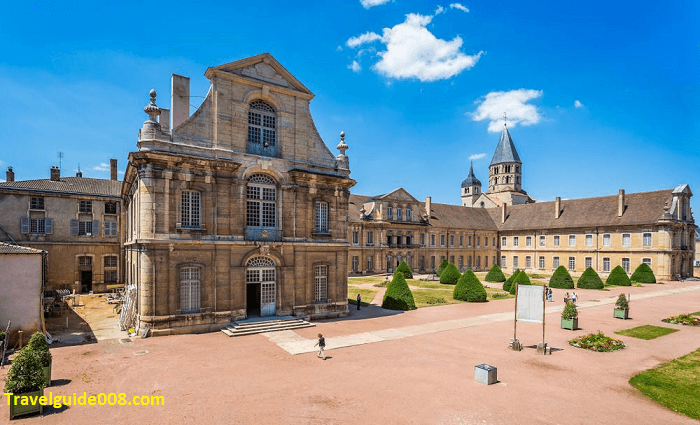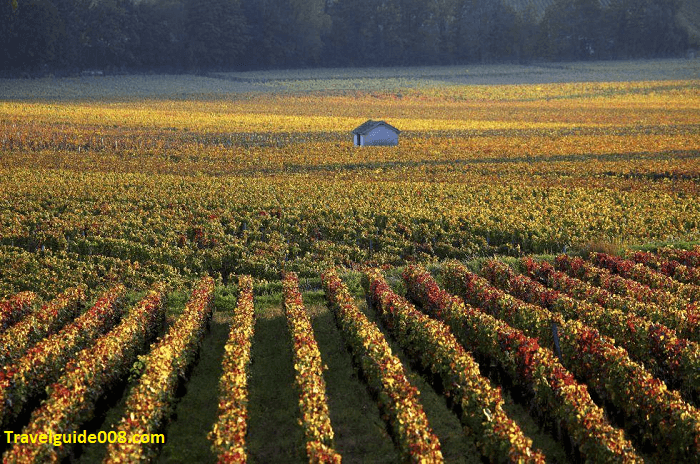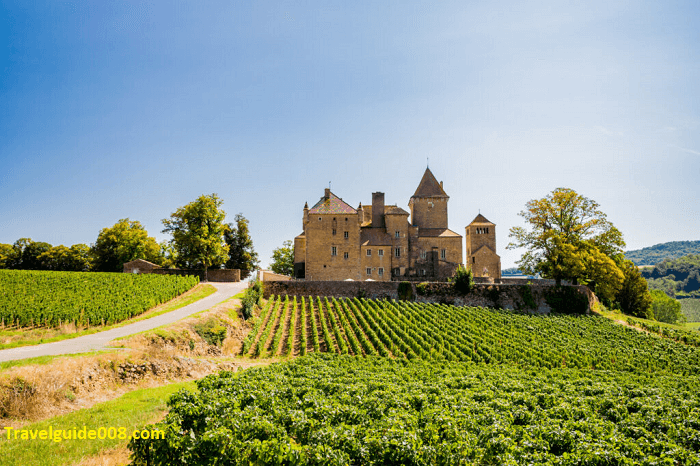Travel Guide to Burgundy, France:
Burgundy France is another name for Bourgogne in French, and it is one of Europe’s oldest historic regions. Deeply drenched in history and culture, with amazing gastronomic delights, it lies in the heart of France, thereby becoming very well known worldwide for some of its world-class wines, rolling vineyards, mediaeval towns, and several rich historical landmarks. If you are a wine tourist, a history buff, or just looking for breathtaking scenery, Burgundy has it all.
In this practical guide, we will discuss the must-see places, activities, and helpful tips on how to enjoy your trip to Burgundy.
Overview of Burgundy:
The region of Burgundy is located in the east of France and borders Champagne-Ardenne to the north, Franche-Comté to the east, Rhône-Alpes to the south, and Centre-Val de Loire to the west. The total number of departments in Burgundy is four: Côte-d’Or, Saône-et-Loire, Yonne, and Nièvre. Dijon, the capital of Burgundy, is not only known for its mustards but also for great historical heritage and a good cultural scene.
Its wines and cuisine are the two major wealth factors of Burgundy. A few of the world’s most famous wine regions lie within this region, like Chablis, Gevrey-Chambertin, or Pommard. One of the mainstays of the Burgundian culinary tradition includes escargots de Bourgogne (snails), coq au vin (chicken cooked in red wine), and boeuf bourguignon (beef stewed in red wine) among others, and all may be savoured at a Michelin-starred restaurant or a quiet village bistrot.
The region is not only famous for its culinary world but also has a great natural landscape with vast forests, rolling hills, and the peaceful Canal du Nivernais that connects the rivers of this region. Charming towns and mediaeval villages are scattered all over the region, many of which have preserved their centuries-old architecture and traditions.

Best Time to Visit Burgundy:
The best time to visit Burgundy depends on what you are interested in, though spring and autumn are the best seasons when the weather is not too harsh and there’s a chance to explore the majority of notable attractions in the region.
- Spring: April to June. Spring in the Burgundy region is marked by gentle temperature together with blooming flowers. There are fewer tourists, so it’s a good time to visit the vineyards and the quaint villages without the crowds. The vineyards start sprouting out with green shoots, and the countryside is lush and vibrant.
- July to August : This happens to be the peak tourist season in Burgundy with amicable weather and numerous festivals. Still, it tends to be very crowded, especially in cities like Dijon and Beaune. Wine festivals and cycling on the Canal de Bourgogne form part of summer. This is specifically for wine lovers.
- Fall: A great and probably the most magical time to visit Burgundy is fall, when the vineyards bloom during harvest season. Colourful grapevines in golden-red and purple hues can be viewed. The fall is also at the height of the wine harvesting festival and wine tasting ceremonies, particularly in September and October.
- Winter (November to March): Though the winter season is rather cold in Burgundy, it is also low season, thus least crowded. Many attractions and wineries are open, and you can experience the Burgundian snugness-thus perfect for sipping a glass of wine by the fire.
1.Dijon: The Heart of Burgundy:
Dijon, for instance, is a city to visit while going through the region, world-known for its mustard called Dijon mustard. It has a history and a high architectural heritage from Roman times until today.
- Place de la Libération: A great square surrounded by elegant 17th-century buildings and the Palais des Ducs (Palace of the Dukes of Burgundy), where you can learn about the mediaeval and Renaissance history of the region.Fine arts museum, Musée des Beaux-Arts Located in the Palace of Dukes, the fine art museum has a good European collection of art from Mediaeval to modern times.
- The Dijon Mustard Shop: For mustard-crazied visitors, this shop makes for a fun experience of how you can taste different versions around the world of the infamous Dijon mustard.
2. Beaune:
The Wine Capital of Burgundy This is a charming mediaeval town and is nicknamed the wine capital of Burgundy. Beaune is the wine capital of Burgundy. It holds the headquarters of the majority of Burgundy’s most prestigious producers.
- Hôtel-Dieu (Hospices de Beaune): Once a 15th-century hospital, it now houses a museum, along with its mediaeval architecture and colourful glazed-tile roofs. The site also hosts the famous Hospices de Beaune wine auction, held annually during the second week of November.
- Wine Tasting: Beaune is a wonderful wine-touring place that offers many wine cellars to taste the region’s most excellent wines. From the Grand Cru red Pinot Noir to chardonnay, you’ll get to learn the process behind wine-making and test your findings in practice.
- Vineyards: The rolling countryside around Beaune takes you through rolling vineyards by bike or on foot, with guided wine tours, through those celebrated Côte de Beaune and Côte de Nuits vineyards.

3.Burgundy Chablis: A Wine Lover’s Heaven:
Another celebrated wine region of Burgundy is Chablis, located in the Yonne department. World-famous for its mineral Chardonnay that tends to be crisp and crunchy, Chablis is a must-visit destination for wine aficionados.
- Wine Tastings: Chablis boasts some of the world’s best Chardonnay. There are many different wineries that have tastings and tours so you can really get a feel for the specific terroir here.
- Chablis Wine Festival: This is held every January. It’s an opportunity to soak up local wine culture, including tastings, food pairings, and harvest festivals.
- Chablis Village: The village of Chablis is such a pleasure to walk through, stone cottages lining curvaceous lanes with views of the vineyards on either side.
4.Burgundy France Cluny:
A Mediaeval Jewel Cluny town is a comune in Saône-et-Loire department, and it is essentially a great place for history enthusiasts. Once upon a time, the powerful Abbey of Cluny stood in Cluny, one of the most important monasteries in mediaeval Europe.
- Abbey of Cluny: Founded in the 10th century, at one point it was the largest church in Christendom. Although much of the abbey was destroyed in the 18th century, tourists can visit the site and see what remains of the abbey’s former grandeur.
- Cluny Town: The town itself is pretty, with narrow streets and mediaeval architecture that gives a feel of the town’s monastic past.

5. The Canal du Bourgogne:
More relaxed and picturesque ways to visit Burgundy are cruise tours along the Canal du Bourgogne. The canal runs from Seine to the Rhône River and passes through the county of Burgundy, vineyards, and quaint towns.
- Biking and Walking: The towpath gives excellent opportunities for cycling and walking, affording great vistas of the natural beauty of the region, the vineyards, and peaceful countryside.
- Boat Rentals: You can rent a boat and take a languid cruise along the canal, stopping at quaint villages and tasting local wine and food during the trip.
6.Burgundy France Vezelay and the Vézelay Abbey:
Vézelay, a UNESCO World Heritage location, is one of the loveliest towns of the Burgundy region. Situated atop a hill, the small town is known for being famous for one of the most beautiful examples of mediaeval architecture—Vézelay Abbey as a pilgrimage site in Europe and one of France’s most important churches from mediaeval times.
- Vézelay Abbey: This mediaeval example of the Romanesque architectural style is a masterpiece of those times, known to the visitor for its intricate carvings and breathtaking view overlooking the surrounding countryside.
- The Town: Vézelay is a colourful hilltop village with narrow cobblestone streets, quaint shops and cafes. It’s a peaceful place to explore, offering breathtaking views of the Morvan Regional Natural Park.
7.Morvan Regional Natural Park:
A mecca for lovers of the outdoors, the Morvan Regional Natural Park provides forests and lakes surrounded by rolling hills—a great place to hike, cycle, or spot wildlife.
- Lac des Settons: A very pretty lake surrounded by forests. We rent kayaks and sail over there to enjoy the scenery and what sun we can find by the water.
- Hiking Trails: Among the several trails made available by the park, visitors can hike through various trails of diverse difficulties to better understand the real natural beauty hidden in the region.

Practical Tips for Visiting Burgundy:
- Getting There: Burgundy has excellent train connectivity, and towns like Dijon and Beaune offer direct train to Paris; the TGV gets you into Paris in about 1 1/2 to 2 hours. By car, Burgundy can be reached from Paris or Lyon; if you really wish to discover the vineyards and the villages on your own, then a rental car is pretty much a must.
- Where to Stay: Burgundy offers all types of accommodation—from luxurious hotels and wine estates through charming bed and breakfasts and rural gîtes. Beaune and Dijon are excellent bases for really exploring the region, but beautiful countryside retreats abound for those seeking a more tranquil experience.
- Wine Tours: If you are a wine lover, you really must make a guided tour. Most of the local cellars on the wine route of Burgundy offer tours, tastings, and even cooking courses to prepare traditional dishes with Burgundy wines.

